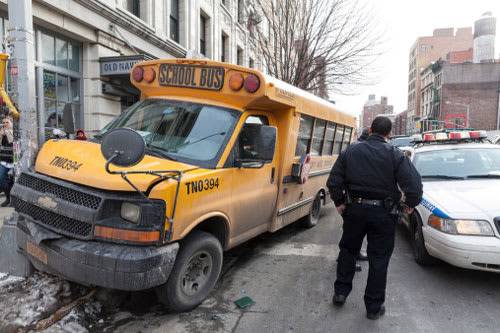School Bus Seat Belts May Save Lives


When I was little my friends and I entertained ourselves on the school bus with a little game of “seat ejection.” We waited for the bus to hit a bump and then launched ourselves as high up out of the seat as possible. Whoever went the highest, won. With three children of my own now who also occasionally ride the school bus, these types of games terrify me. When I hear of tragic school bus accidents, often due to children being unrestrained, I really start to worry. “GMA” Investigates, from “Good Morning America,” was also concerned and spent some time digging into the question, “Can seat belts on school buses save lives?”
Related: More Safety News
Current laws require that all small school buses (less than 10,000 pounds) must have seat belts in them. There are only six states that require all school buses, regardless of size, to have seat belts: California, Florida, Louisiana, New Jersey, New York and Texas. Why aren’t there more?
According to safety experts, school buses use what’s referred to as “compartmentalization” to keep kids safe on buses. Since the seatbacks of school buses are high and padded, the theory is that kids would essentially bounce around inside their seating area without too much possible damage to themselves or the other children in front or behind them. This is sometimes also called the “egg carton” technique. The real question is what happens to those kids in the event of a school bus rollover.
IMMI, an organization that “designs, tests and manufactures advanced safety systems” including those in some school buses, wondered the same thing. With “GMA” cameras rolling, IMMI recently ran school buses through several types of crash tests with child-size dummies inside. Some were restrained in three-point seat belts and the others were unrestrained. The video is dramatic and clearly shows the unrestrained “children” flying out of their seat compartments and smashing their heads on the roof before settling into a heap on top of one another. The restrained dummies remained in their seats the entire time.
The National Highway Traffic Safety Administration is also reviewing this issue with a fresh perspective from its new chief, Mark Rosekind. In his interview with “GMA” Investigates, Rosekind said, “I’m the new guy, fresh eyes. Does that mean we might change things? We may. We’re gonna look for every action we can take to help those kids be safer.”
While I’m most certainly in favor of implementing change that will save even one innocent life, it’s equally important to maintain perspective. Statistically speaking, our children are exponentially safer in school buses than they are in passenger cars. According to NHTSA, on average, four children die in school buses each year, compared to the approximately 90 people on average that die in passenger cars daily.
What about you, how comfortable do you feel with your children riding the bus to school unrestrained?
iStock/Thinkstock

Former Senior Family Editor Kristin Varela blends work and family life by driving her three tween-teen girls every which way in test cars.
Featured stories

15-Year Car Loans Aren’t a Thing, But Americans Are Getting More Comfortable With Long Loan Terms

2025 Kia Telluride Review: Rougher Roads Ahead



